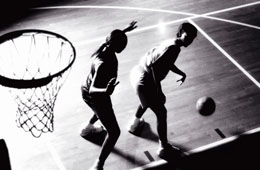High School Football Rule Question
Question
QUESTION: I am a high school football official. My question pertains to a blocked scrimmage kick and touching in the expanded neutral zone. Here's the situation: (R) blocks the scrimmage kick behind the line. The blocked kick is grounded, muffed around by both (R) and (K) behind the line of scrimmage and ends-up beyond the line of scrimmage in the expanded neutral zone. (R)is the first to touch the kick once it goes beyond the line, but it is still in the expanded neutral zone. (K) then recovers the kick, still in the expanded neutral zone. My understanding of the rule on "Touching" is that all touching by either (K) or (R) of a scrimmage kick in the expanded neutral zone is ignored. In this case, if (K) recovers they cannot advance because the ball is beyond the neutral zone. It would not automatically be a new series for (K) because the touching by (R) is ignored. However, if the kick recovered by (K)in the expanded neutral zone happened to be beyond the yard-to-gain it would be a 1st down for (K). If the ball had gone beyond the expanded neutral zone and (R) touched it first and (K) recovered, (K) could not advance but it would automatically be a new series of downs for (K) if no penalties. Do I have this correct. Thank You.
ANSWER: Paul this is a great Rules question for discussion. As you know Rules 6-2-4 and 6-2-5 govern this play. The rule is not well developed in regard to your question as you likely know. Common sense and football sense must prevail. K is punting the ball - giving it up to R having failed to achieve a first down. That is why K is punting. That is the football sense.
So to answer the question you must know where R touches the ball. Your play situation has R touching the ball "in the expanded neutral zone" - "(R)is the first to touch the kick once it goes beyond the line, but it is still in the expanded neutral zone." If K is to end up with team possession legally for a new series R has to touch the ball :"'CLEARLY' BEYOND THE NEUTRAL ZONE". The rule requires R to touch the ball not just beyond but clearly beyond the NZ. Here R is still in the NZ expanded when it touches the ball.
You are correct if (K) recovers they cannot advance. However K's kick goes beyond the NZ [Rule 6-2-3] K does not get the Expanded NZ in this instance. It is contrary to the purpose expressed in Case Book play situation 6-2-6 to allow K to achieve a first down on this play when R's touching was not clearly beyond the Expanded NZ.
It should be R's ball 1st and 10 from the spot where K gained possession. [ I used to think the rule supported giving it to K 1st & 10, but that is not within the spirt of the rules 6-2-3, 6-2-4, 6-2-5 or the case book plays rulings.] Don't be so technical you miss the common sense application.
Again, this is a great study question and great for teaching!!
---------- FOLLOW-UP ----------
QUESTION: Thank you Victor. I am with you on the "common sense application" and the fact that (K) gave up the ball after failing to achieve the 1st down. I am fine with the common sense application where the rules are not clear, but I am still struggling with this situation because the rules seem clear. Touching of a scrimmage kick by both (K) and (R)is clearly ignored in the expanded neutral zone. If so, it seems it must be a free ball, which (K) can recover, but cannot advance. If they can recover it, it seems it should also be a first down if beyond the line-to-gain
(K) has also given up the ball if the kick goes beyond the expanded neutral zone, yet (K) is awarded a new series if (R) is the first to touch the kick beyond the expanded neutral zone, presumably because (R) freely made a play on the kick. The rules seem to clearly want the expanded neutral zone to be an "exception" where either team may touch the kick and it is ignored. Case 2-28-2 goes so far to state that the neutral zone is "automatically" expanded 2 yards behind the defensive line of scrimmage on scrimmage kicks.
Rule 5-1-4 also seems to support that (K) could retain possession of the kick, but the down counts. This rule specifically mentions "in" or "behind" the neutral zone. I would take this to include the "expanded neutral zone" since the neutral zone is automatically expanded during a scrimmage kick. Doesn't this mean that if (K) could legally possess the ball and the down counts, it should be a 1st down for (A or K) if the possessed ball ends up beyond the line to gain (5-3-a)? If so, wouldn't it also be true that a scrimmage kick which ends-up in the expanded neutral zone, recovered by (K or A) could be a 1st down for (K or A) if beyond the line-to-gain, since any touching of the kick by either (K) or (R) in the expanded neutral zone is clearly ignored?
Thanks for working with me on this. I'm really not trying to be a technocrat on this, and there is always room for judgment and interpretation, but if a rule covers a situation then the rule should prevail. I'm just trying to make sure I understand the rule.
Thank you.
ANSWER: Paul
Go back to 6-2-4 K may catch or recover the scrimmage kick [ball] :
1) while it is beyond the NZ, or 2) beyond the expanded NZ the NZ; AND
3) PROVIDED the kick was touched by R "clearly" beyond the Expanded NZ [touching by R has to be clearly beyond the NZ] for K to be able to retain possession. In your play situation "(R)is the first to touch the kick once it goes beyond the line, but it is still in the expanded neutral zone." This is not "clearly beyond" the NZ.
K can recover a punt untouched by R (or touched by R in the NZ) that goes 40 yards beyond the NZ (beyond the line to gain). The recovery causes the ball to become dead in K's possession but the ball belongs to R 1st & 10 at that spot. Same thing here, R touches the ball in the NZ, (not clearly beyond) and K recovers. The Kick becomes dead once recovered by K. The ball belongs to R 1st and 10 at that spot. I hope you are with me in this rationale.
I agree with you in part about the expanded NZ. The rules seem to want the expanded neutral zone to be an "exception" where the scrimmage kick is low but airborne [not grounded] and it is intended to allow K lineman to block downfield without penalty. The purpose of the expanded NZ is for line play not allowing K to get another chance for a new series of downs. Read Case book situation 6-2-6 that may help you.
Good point about Rule 5-1-4. Honestly I had not considered that rule specifically, but generally. I want to think about this some more and look through some old rule committee notes. I am not convince that K keeps the ball because 5-1-4 talks about R touching the ball beyond the NZ while 6-2-4 talks about R touching being clearly beyond the NZ. Lastly, in your play "(K) then recovers the kick, still in the expanded neutral zone", I am not sure about this whether the NZ is intended to remain expanded at that time since the kick is grounded. I realize by rule when the expanded NZ disintegrates but remember for the expanded NZ to exist there needs to be a kick in flight.
Paul you might have me changing my opinion on this. I think you do know the rule very well and as I mentioned in my first response this rule is not well developed in regard to your question. Unfortunately HS football doesn't have the officiating philosophies as college football. For now I still believe it it becomes R's ball. I will do some more research and follow up.
---------- FOLLOW-UP ----------
QUESTION: Victor, I appreciate your patience in working through this with me.
I had previously searched the rule book and case book for anything which would clarify the expanded neutral zone and when it disintegrated. In Case 6-2-6 it is clear that the expanded neutral zone disintegrates once the kick crosses the expanded zone, but in my situation the kick never got to that point.
Likewise, I found nothing in the rules or cases which made any reference at all to the expanded zone being tied to a scrimmage kick in flight or grounded. I take that to mean that as long as it remains a kick, whether in flight or grounded, the expanded zone remains in effect until the kick crosses the expanded zone.
I believe the rules and cases, as written, support the following:
a. Either team can recover and advance a scrimmage kick, in-flight or grounded if the kick ends up behind the line of scrimmage.
b.(R) can advance anywhere on the field except if a Fair Catch.
c. Once the kick goes beyond the expanded neutral zone, the only way (K) can obtain possession is if (R) touches the ball first, and then it is a new series for (K) provided they gain possession, and no mitigating penalty.
d. If the kick does not cross the expanded neutral zone, touching by either team is ignored, whether in-flight or grounded, and there could be multiple touches by either team.
e. If the kick ends-up in the expanded neutral zone, either team may recover, but (K) cannot advance if the kick has crossed the neutral zone.
f. If (K) legally recovers a kick behind the neutral zone or expanded neutral zone, the down counts and, if 4th down, they must achieve the yard-to-gain for a 1st down. If behind the line, they have the opportunity to advance the ball for a 1st zone. If in the expanded zone they cannot advance, but it could be a 1st down if recovered beyond the yard-to-gain.
g. Once the kick goes beyond the expanded zone and (K) is the first to touch it, it will be (R)'s ball if no mitigating penalties.
Please let me know if I have it right. Thanks.
Answer
Paul
I still am not 'completely" convinced of all your reasoning that K ends up with the ball, but you do have me trying to research a the play situation - looking at old case books, memos, rules tests, etc. - and I am not ready to say you are wrong or I am correct. Rest assured you do have a great grasp of the rule. I will go through your last question and let you know my thoughts on each.
I believe the rules and cases, as written, support the following for scrimmage kicks:
a. Either team can recover and advance a scrimmage kick, in-flight or grounded if the kick ends up behind the line of scrimmage. I AGREE WITH YOU AND YOU ARE CORRECT.
b.(R) can advance anywhere on the field except if a Fair Catch. I AGREE WITH YOU AND YOU ARE CORRECT.
c. Once the kick goes beyond the expanded neutral zone, the only way (K) can obtain possession is if (R) touches the ball first, and then it is a new series for (K) provided they gain possession, and no mitigating penalty. I DO NOT TOTALLY AGREE - R MUST HAVE TOUCHED THE BALL "CLEARLY BEYOND" THE NZ
d. If the kick does not cross the expanded neutral zone, touching by either team is ignored, whether in-flight or grounded, and there could be multiple touches by either team. I DISAGREE WITH THIS. THE INTENT OF THE RULE FOR THE EXPANDED NZ 1 BELIEVE PERTAINS TO IN FLIGHT KICKS OR LOW KICKS [CASE BOOK PLAY SITUATION 6-2-6]. I STILL AM NOT CERTAIN IT APPLIES TO GROUNDED KICKS - HOWEVER, IF THE KICK GOES BEYOND THE NZ ANY TOUCHING IN THE NZ SHOULD BE IGNORED BY THE INTENT OF THE RULE. RULE 6-2-6
e. If the kick ends-up in the expanded neutral zone, either team may recover, but (K) cannot advance if the kick has crossed the neutral zone. THIS IS THE ASPECT OF YOUR QUESTION I AM STILL RESEARCHING RULES 5-1-4, 6-2-3, 6-2-4, 6-2-5, 6-2-6
f. If (K) legally recovers a kick behind the neutral zone or expanded neutral zone, the down counts and, if 4th down, they must achieve the yard-to-gain for a 1st down. If behind the line, they have the opportunity to advance the ball for a 1st zone. If in the expanded zone they cannot advance, but it could be a 1st down if recovered beyond the yard-to-gain. AGAIN THIS IS THE ASPECT OF YOUR QUESTION I AM STILL RESEARCHING RULES 5-1-4, 6-2-3, 6-2-4, 6-2-5, 6-2-6
g. Once the kick goes beyond the expanded zone and (K) is the first to touch it, it will be (R)'s ball if no mitigating penalties. I AGREE WITH YOU AND YOU ARE CORRECT
Please let me know if I have it right. Thanks.
I AM ABOUT TO TURN THE QUESTION OVER TO THE STATE RULES INTERPRETER FOR THE NFHS.
Paul,
I have not forgotten about you. I have kicked your question around and done a lot of research. Also have contacted officials in other states [Texas, Colorado, California, Oregon, Nevada, Utah, Hawaii, North Carolina. So the safe diplomatic response is for you to contact your STATE RULES INTERPRETER. I want to make it clear I do not speak for the NFHS Rules Committee nor any STATE RULES INTERPRETER. With that disclaimer, you have a great grasp onthe rule. Rogers Redding and George Demetriou's National Federation Rules Study Guide 7 or 8 years ago addressed a question very similar to this. [ http://www.doublesdistributors.com/order.htm ] I do not have Rogers Redding's high school rule study guide, I only use his NCAA study guide and those are the only ones in my library. After discussing your play situation I would rule that the Expanded NZ disintegrates when the ball is grounded [blocked behind the NZ and then bounced into and beyond]. That is not inthe rule book but seems to follow the intent of the rationale for the expanded NZ - to permit touching by linemen in the expanded NZ to be ignored during scrimmage kicks with low trajectory. The fact that the intent behind the rule pertains to low kicks or the kick's trajectory [path of the inflight kicked ball] which could be touched by linemen.
With that said, if R touches the kick [grounded or inflight] clearly beyond the NZ and K recovers the ball it is K's ball 1st and 10.
I would encourage you to write to your state's rule interpreter and Bob Colgate the NFHS Football Rules Editor and get an official ruling from the NFHS.
I truly have no doubt you have an excellent understanding of the rule.
Recruiting
how to get a better arm


